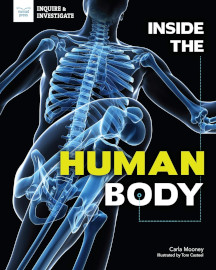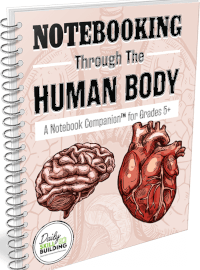Inside the Human Body by Carla Mooney (published by Nomad Press) teaches about the systems of the human body in a heavily illustrated format, suitable for students in grades five through ten. It includes some activities, but it’s not easy to use as a core text on its own. Enter Daily Skill Building’s Notebooking Through the Human Body: A Notebook Companion™ for Grades 5+ that fills the gaps. Using the two books together makes a complete course. Even better, students can work through it independently.
Inside the Human Body
 Inside the Human Body by Carla Mooney is a 120-page, full-color book with plenty of photos, charts, drawings, and cartoon strips that are critical for conveying course content. The text in the book, as presented in Chapters 1 through 9, is written at an introductory level appropriate for middle school and up. The introductory chapter, a 10-page introduction titled, “Let’s Talk about the Human Body,” seems to have been written for a more sophisticated audience, with discussions, for example, of three of the anatomical planes (Sagittal, Frontal, and Transverse) that can pass through the human body. I couldn’t find these technical terms and concepts addressed anywhere else in the book. So don’t be put off if you think the introduction too technical.
Inside the Human Body by Carla Mooney is a 120-page, full-color book with plenty of photos, charts, drawings, and cartoon strips that are critical for conveying course content. The text in the book, as presented in Chapters 1 through 9, is written at an introductory level appropriate for middle school and up. The introductory chapter, a 10-page introduction titled, “Let’s Talk about the Human Body,” seems to have been written for a more sophisticated audience, with discussions, for example, of three of the anatomical planes (Sagittal, Frontal, and Transverse) that can pass through the human body. I couldn’t find these technical terms and concepts addressed anywhere else in the book. So don’t be put off if you think the introduction too technical.
Sidebars add interesting tidbits of information, occasional vocabulary assignments, personal reflection questions, and QR codes (most for videos such as “Big Guns: The Muscular System – CrashCourse Biology #31.”) A list of additional recommended books and websites on page 116 suggests even more resources if you need them. The book includes both a glossary and an index.
Aside from the introduction, every chapter has an experiment or activity, and the last chapter has two. Most of these are practical while a few might be tough to accomplish. Building an artificial arm to demonstrate how arm muscles work (page 34) should be manageable. But gathering a group of volunteers to exercise and test various antiperspirants, and measuring results by comparing the amount of sweat on clothing or headbands (page 109) seems problematic, especially because of the difficulty of measuring sweat. Students need not complete all the experiments, so this shouldn’t be an issue.
Notebooking Through the Human Body
 Notebooking Through the Human Body: A Notebook Companion™ for Grades 5+ from Daily Skill Building makes it much easier to get the most from Inside the Human Body. You can purchase this book as a PDF, a spiral-bound book, or a bundle with both. Purchasers also receive a PDF file with experiment templates that are especially useful for helping older students record and analyze data from experiments. If students plan to add their own drawings, data from experiments, reports, or other work, it might be preferable to work from the PDF, punching holes in pages and inserting all of them into a binder.
Notebooking Through the Human Body: A Notebook Companion™ for Grades 5+ from Daily Skill Building makes it much easier to get the most from Inside the Human Body. You can purchase this book as a PDF, a spiral-bound book, or a bundle with both. Purchasers also receive a PDF file with experiment templates that are especially useful for helping older students record and analyze data from experiments. If students plan to add their own drawings, data from experiments, reports, or other work, it might be preferable to work from the PDF, punching holes in pages and inserting all of them into a binder.
While the learning process of Notebooking Through the Human Body is described as notebooking, it’s not an arts-and-crafts approach. Rather, it’s a way to easily compile all student work. In this notebook, students write definitions of vocabulary words, answer questions, label drawings, complete charts, create their own drawings, complete graphic organizers, and write up experiments. All of this is done with reference to content in Inside the Human Body.
The answer key located at the back of the Notebooking Through the Human Body directs students or parents to the specific page and paragraph(s) within Inside the Human Body where they can find the correct answers.
Before the answer key are 53 pages of vocabulary cards to be created by students—four cards per page with only a term and chapter number already on the cards. Some students will find writing and studying definitions within the chapters of the notebook sufficient while others will benefit from creating the vocabulary cards. Note that the pages with vocabulary cards in the printed book are printed back-to-back and do not align perfectly, so check this before printing from the PDF, and do the best you can if cutting out from the printed book.
A single template, reprinted for each experiment, is provided for students to write up each experiment, but some require more data recording than others, and no space is provided for that. This is where the supplemental file of experiment templates comes in handy.
The introduction to the book says that you shouldn’t grade or critique student work in their notebook. This is the same generic introduction that Daily Skill Building provides for some of their other notebooks. But with this course, and especially for students in junior high, I think parents will want to hold students accountable for accurate definitions, drawings, and responses to questions.
Free Supplements
The introduction provides a URL for a page to access free printables that can be used along with this notebook. Among them are labeling worksheets for the parts of different body systems, 40 anatomy coloring pages, a 78-page copywork vocabulary book (best for younger students), and six Disease Notebooking Research Journals (good for older students). Don’t miss these!
Summary
Notebooking Through the Human Body and Inside the Human Body work well together as an inexpensive, easy-to-use course for learning about the human body.








